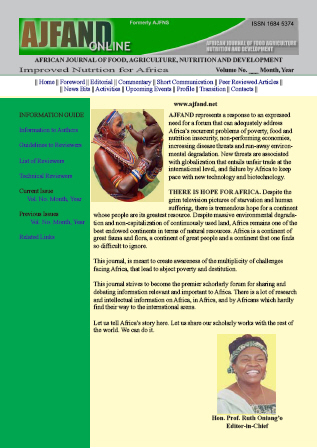
|
African Journal of Food, Agriculture, Nutrition and Development
Rural Outreach Program
ISSN: 1684-5358
EISSN: 1684-5358
Vol. 11, No. 3, 2011, pp. 4800- 4809
|
 Bioline Code: nd11030
Bioline Code: nd11030
Full paper language: English
Document type: Research Article
Document available free of charge
|
|
|
African Journal of Food, Agriculture, Nutrition and Development, Vol. 11, No. 3, 2011, pp. 4800- 4809
| en |
Soil Characterization In Contrasting Cropping Systems Under The Fast Track Land Reform Programme In Zimbabwe
Shoko, M.D. & Moyo, S.
Abstract
Soil fertility depletion is a major limitation to crop production in sub-Saharan Africa and Zimbabwe is no exception to this phenomenon. This research was conducted to assess the soil chemical characteristics in three contrasting cropping systems of Zimbabwe. The contrasting production systems under study were communal area, A2 (large scale resettlement) and A1 (small scale resettlement).All these systems are in Manicaland province, Zimbabwe. The A1 and A2 production systems were brought about during the 2000 land reform programme. The soil samples were collected during the off season of 2006, 2007 and 2008. The following soil chemical characteristics were determined: Ca, Mg, K, Zn, pH and organic matter. There were significant differences (P=0.001) between the production systems and soil chemical properties. Calcium, magnesium and potassium levels were generally low in all the three production systems. This was due to low soil pH. However, A2 farms had significantly the highest (P<0.05) Ca, Mg and K while communal area had significantly the lowest (P<0.05) soil organic matter content. The soil organic matter content in A2 farms can sustain plant growth. This could also be compounded by good land management practices such as fertilisation and liming. However, there may be need for the communal and A1 farmers to apply organic matter so as to boost SOM in their fields. The optimum soil organic matter in Zimbabwe is from 1.5% to 5%. Results showed that soil pH was between 5.0 and 6.8 (slightly acidic), in all the three production systems. However, it was strongly acidic in communal areas at 0-30cm depth. Soil acidity in communal areas impacted negatively on the yield of maize and groundnut. In the A1 and A2 farms acidity levels may sustain the production of crops like tobacco and sunflower. Generally, there is need for the farmers in the three production systems to lime the soils and improve their organic matter through addition of crop residues and cattle manure.
Keywords
soil nutrients, farmers, land systems
|
| |
© Copyright 2011 African Journal of Food Agriculture, Nutrition and Development.
Alternative site location: http://www.ajfand.net/
|
|
